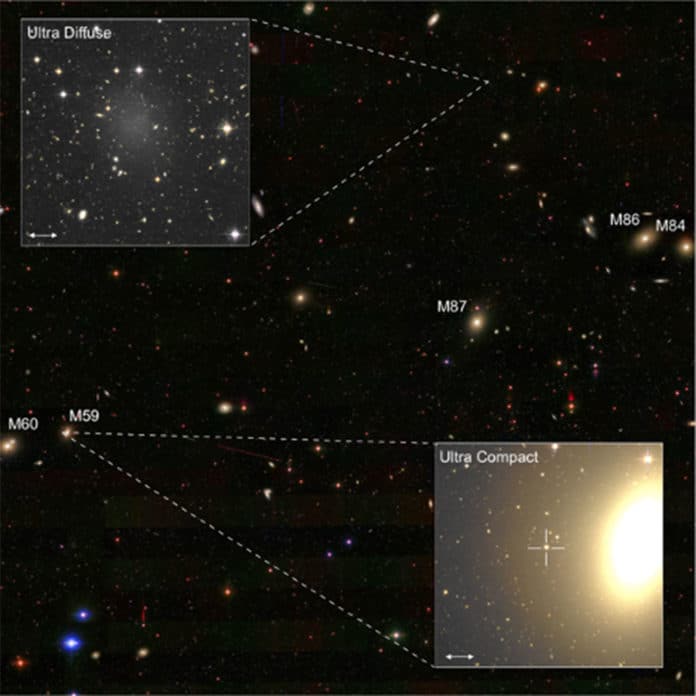The study of both ultra-compact and ultra-diffuse galaxies in the Virgo Cluster-based data from the Next Generation Virgo Cluster Survey (NGVS) obtained at the Canada-France-Hawaii Telescope (CFHT) using MegaCam, a wide-field, optical camera- suggests that such galaxies reside in dense environments.
Based on their investigation, astronomers speculate that the key to understanding galaxies with “extreme” sizes, either small or large, may lie in their surroundings. It suggests objects could have started out resembling normal galaxies, developed to have unusual sizes through interactions with other galaxies.
Dr. Chengze Liu of Shanghai Jiao Tong University, lead author of the first study, said, “We found hundreds of UCDs in the nearby Virgo galaxy cluster, and at least some of them appear to have started their lives as larger galaxies.”
While UCDs are comparable in appearance to a large star cluster, various UCDs in this study were found with faint stellar envelopes encompassing the central, compact core. These envelopes could be the last remnants of a galaxy that has steadily been stripped away by gravitational tidal forces from neighboring galaxies.
Also, UCDs were found to occupy the Virgo cluster’s regions with the highest galaxy densities. Together, these bits of proof highlight an environmentally induced change as being liable for delivering some UCDs.
Ultra-diffuse galaxies (UDGs) are a mystery at the other end of the size spectrum. They are much larger and more diffuse than typical galaxies with similar brightness. Some theories suggest that UDGs are massive galaxies whose gas —- the fuel for their star formation —- was removed before many stars could form.
Dr. Sungsoon Lim of the University of Tampa, and the lead author of the second study, said, “We found that the ultra-diffuse galaxies in the Virgo cluster are more concentrated toward the dense cluster core, indicating that a dense environment may be important for their formation. The diversity in their properties indicates that while no single process has given rise to all objects within the UDG class, at least some UDGs have appearances suggesting their diffuse nature is due to tidal interactions or the merger of low-mass galaxies.”
Prof. Eric Peng of Peking University’s Kavli Institute for Astronomy and Astrophysics said, “Another mystery is that some ultra-diffuse galaxies were found to contain significant populations of globular star clusters. The intense star-forming events needed to make globular clusters generally make a galaxy less, rather than more diffuse, so understanding how we get globular clusters in ultra-diffuse galaxies is an interesting challenge.”
Dr. Patrick Côté of the National Research Council of Canada’s Herzberg Astronomy and Astrophysics Research Center said, “To find truly unusual galaxies, you first need to understand the properties of so-called normal galaxies. NGVS provides the deepest, most complete look at the entirety of the Virgo cluster galaxy population, allowing us to find the most compact and most diffuse galaxies, advancing our understanding of how they fit into the general picture of galaxy formation.”
Journal Reference:
- Sungsoon Lim et al., The Next Generation Virgo Cluster Survey (NGVS). XXX. Ultra-diffuse Galaxies and Their Globular Cluster Systems, The Astrophysical Journal (2020). DOI: 10.3847/1538-4357/aba433 , arxiv.org/abs/2007.10565
- Chengze Liu et al. The Next Generation Virgo Cluster Survey. XXXIV. Ultracompact Dwarf Galaxies in the Virgo Cluster, The Astrophysical Journal Supplement Series (2020). DOI: 10.3847/1538-4365/abad91 , arxiv.org/abs/2007.15275
